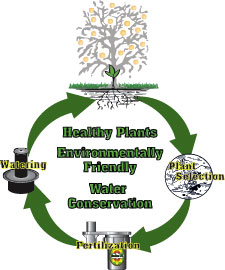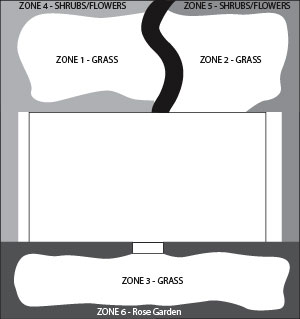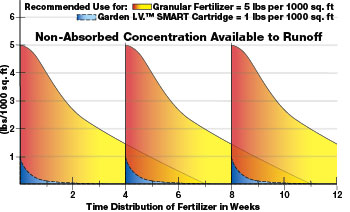|
|
|
Healthy Plants
|
 |
Why Fertilize?
Plants need a supply of 14 nutrients in order to grow and thrive. The 3 main nutrients are Nitrogen, Phosphorous, and Potassium. As stated by the Natural Resource Conservation Service, “Nitrogen is associated with lush vegetative growth, adequate Phosphorus is required for flowering and fruiting, and Potassium is necessary for durability and disease resistance.” The remaining micronutrients include Calcium, Magnesium, Sulfur, Molybdenum, Nickel, Copper, Zinc, Manganese, Iron, Boron, and Chlorine. A deficiency in any of these elements can cause abnormal growth including discoloring, growth stunting, and death. Excess watering will not cure the condition of the nutrient deficient plant.
|
 |
-The Zone-By-Zone Approach
Different types of plants need different concentrations nutrients. Furthermore, even for the same plants, the nutrient concentrations can be more efficient at different times of the year. Four, seasonally changing programs have been developed to match the typical sprinkler station design. The formulas are Lawn, Shrubs and Flowers, Roses, and Tropical. Once a month, a package of color coded cartridges is delivered to the home and the gardener matches the color to the appropriate sprinkler valve.
|
|
|
|
|
|
Environmentally Friendly
|
|
|
 Many people don’t understand that even if they live miles from the ocean, they may be unknowingly polluting it. Also, people don’t realize that the largest source of pollution comes from city streets, neighborhoods, construction sites, parking lots and overflow by poorly aimed sprinklers. Source www.ocwatershed.com. Further information on Water Pollution. Many people don’t understand that even if they live miles from the ocean, they may be unknowingly polluting it. Also, people don’t realize that the largest source of pollution comes from city streets, neighborhoods, construction sites, parking lots and overflow by poorly aimed sprinklers. Source www.ocwatershed.com. Further information on Water Pollution.
The Garden I.V. approach is to minimize the amount of unabsorbed materials in the landscape at any give time.
|
|
|
-Water Schedule to enhance root growth
A well designed home irrigation system divides the garden into zones that contain plants with similar watering needs. For example, a zone containing shrubs and flowers needs longer, less frequent watering than a zone which contains grass. This deeper watering promotes deeper roots, so the plant can reach sources of water deeper in the soil. The plants in each zone also have different nutrient needs. For example, grass needs a higher concentration of Nitrogen to promote greening. With the Garden I.V. it is possible to tailor both the water and nutrients by zone.
|
|
|
|
|
|
Water Conservation
|
|
|
Preliminary estimates indicate that total energy used to pump and treat this water exceeds 15,000 GWh per year, or at least 6.5 percent of the total electricity used in the State per year. Urban water use constitutes about 20 percent of the water used in California. “On average, 60 percent of water used in Orange County is for outdoor irrigation, which makes the potential for water savings enormous,” said Michelle Tuchman, water district spokeswoman. Therefore, increasing the efficient use of water in landscapes will have a large impact on the total electrical needs of the state.
|
|
|
 |
 |









